Ye Shi
UniDB: A Unified Diffusion Bridge Framework via Stochastic Optimal Control
Feb 09, 2025



Abstract:Recent advances in diffusion bridge models leverage Doob's $h$-transform to establish fixed endpoints between distributions, demonstrating promising results in image translation and restoration tasks. However, these approaches frequently produce blurred or excessively smoothed image details and lack a comprehensive theoretical foundation to explain these shortcomings. To address these limitations, we propose UniDB, a unified framework for diffusion bridges based on Stochastic Optimal Control (SOC). UniDB formulates the problem through an SOC-based optimization and derives a closed-form solution for the optimal controller, thereby unifying and generalizing existing diffusion bridge models. We demonstrate that existing diffusion bridges employing Doob's $h$-transform constitute a special case of our framework, emerging when the terminal penalty coefficient in the SOC cost function tends to infinity. By incorporating a tunable terminal penalty coefficient, UniDB achieves an optimal balance between control costs and terminal penalties, substantially improving detail preservation and output quality. Notably, UniDB seamlessly integrates with existing diffusion bridge models, requiring only minimal code modifications. Extensive experiments across diverse image restoration tasks validate the superiority and adaptability of the proposed framework. Our code is available at https://github.com/UniDB-SOC/UniDB/.
Evaluating Image Caption via Cycle-consistent Text-to-Image Generation
Jan 08, 2025



Abstract:Evaluating image captions typically relies on reference captions, which are costly to obtain and exhibit significant diversity and subjectivity. While reference-free evaluation metrics have been proposed, most focus on cross-modal evaluation between captions and images. Recent research has revealed that the modality gap generally exists in the representation of contrastive learning-based multi-modal systems, undermining the reliability of cross-modality metrics like CLIPScore. In this paper, we propose CAMScore, a cyclic reference-free automatic evaluation metric for image captioning models. To circumvent the aforementioned modality gap, CAMScore utilizes a text-to-image model to generate images from captions and subsequently evaluates these generated images against the original images. Furthermore, to provide fine-grained information for a more comprehensive evaluation, we design a three-level evaluation framework for CAMScore that encompasses pixel-level, semantic-level, and objective-level perspectives. Extensive experiment results across multiple benchmark datasets show that CAMScore achieves a superior correlation with human judgments compared to existing reference-based and reference-free metrics, demonstrating the effectiveness of the framework.
AffordDP: Generalizable Diffusion Policy with Transferable Affordance
Dec 04, 2024



Abstract:Diffusion-based policies have shown impressive performance in robotic manipulation tasks while struggling with out-of-domain distributions. Recent efforts attempted to enhance generalization by improving the visual feature encoding for diffusion policy. However, their generalization is typically limited to the same category with similar appearances. Our key insight is that leveraging affordances--manipulation priors that define "where" and "how" an agent interacts with an object--can substantially enhance generalization to entirely unseen object instances and categories. We introduce the Diffusion Policy with transferable Affordance (AffordDP), designed for generalizable manipulation across novel categories. AffordDP models affordances through 3D contact points and post-contact trajectories, capturing the essential static and dynamic information for complex tasks. The transferable affordance from in-domain data to unseen objects is achieved by estimating a 6D transformation matrix using foundational vision models and point cloud registration techniques. More importantly, we incorporate affordance guidance during diffusion sampling that can refine action sequence generation. This guidance directs the generated action to gradually move towards the desired manipulation for unseen objects while keeping the generated action within the manifold of action space. Experimental results from both simulated and real-world environments demonstrate that AffordDP consistently outperforms previous diffusion-based methods, successfully generalizing to unseen instances and categories where others fail.
NLPrompt: Noise-Label Prompt Learning for Vision-Language Models
Dec 02, 2024



Abstract:The emergence of vision-language foundation models, such as CLIP, has revolutionized image-text representation, enabling a broad range of applications via prompt learning. Despite its promise, real-world datasets often contain noisy labels that can degrade prompt learning performance. In this paper, we demonstrate that using mean absolute error (MAE) loss in prompt learning, named PromptMAE, significantly enhances robustness against noisy labels while maintaining high accuracy. Though MAE is straightforward and recognized for its robustness, it is rarely used in noisy-label learning due to its slow convergence and poor performance outside prompt learning scenarios. To elucidate the robustness of PromptMAE, we leverage feature learning theory to show that MAE can suppress the influence of noisy samples, thereby improving the signal-to-noise ratio and enhancing overall robustness. Additionally, we introduce PromptOT, a prompt-based optimal transport data purification method to enhance the robustness further. PromptOT employs text encoder representations in vision-language models as prototypes to construct an optimal transportation matrix. This matrix effectively partitions datasets into clean and noisy subsets, allowing for the application of cross-entropy loss to the clean subset and MAE loss to the noisy subset. Our Noise-Label Prompt Learning method, named NLPrompt, offers a simple and efficient approach that leverages the expressive representation and precise alignment capabilities of vision-language models for robust prompt learning. We validate NLPrompt through extensive experiments across various noise settings, demonstrating significant performance improvements.
SeqAfford: Sequential 3D Affordance Reasoning via Multimodal Large Language Model
Dec 02, 2024
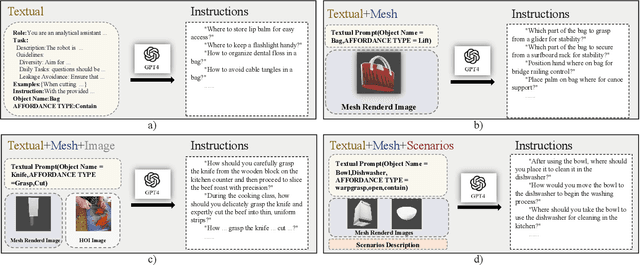
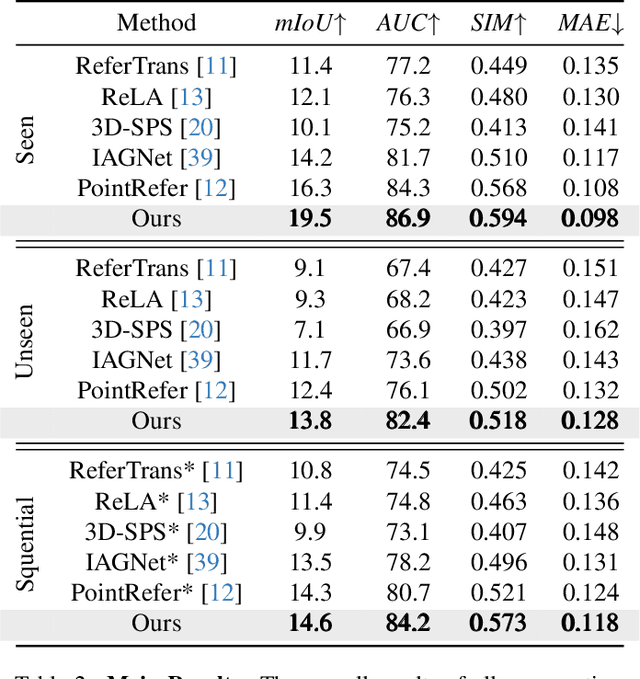
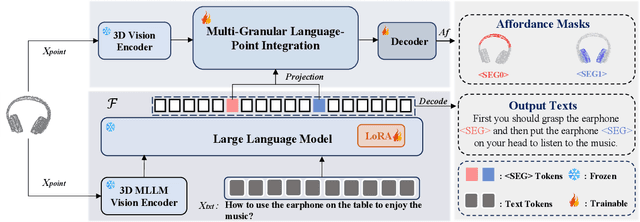
Abstract:3D affordance segmentation aims to link human instructions to touchable regions of 3D objects for embodied manipulations. Existing efforts typically adhere to single-object, single-affordance paradigms, where each affordance type or explicit instruction strictly corresponds to a specific affordance region and are unable to handle long-horizon tasks. Such a paradigm cannot actively reason about complex user intentions that often imply sequential affordances. In this paper, we introduce the Sequential 3D Affordance Reasoning task, which extends the traditional paradigm by reasoning from cumbersome user intentions and then decomposing them into a series of segmentation maps. Toward this, we construct the first instruction-based affordance segmentation benchmark that includes reasoning over both single and sequential affordances, comprising 180K instruction-point cloud pairs. Based on the benchmark, we propose our model, SeqAfford, to unlock the 3D multi-modal large language model with additional affordance segmentation abilities, which ensures reasoning with world knowledge and fine-grained affordance grounding in a cohesive framework. We further introduce a multi-granular language-point integration module to endow 3D dense prediction. Extensive experimental evaluations show that our model excels over well-established methods and exhibits open-world generalization with sequential reasoning abilities.
Understanding Representation of Deep Equilibrium Models from Neural Collapse Perspective
Oct 30, 2024Abstract:Deep Equilibrium Model (DEQ), which serves as a typical implicit neural network, emphasizes their memory efficiency and competitive performance compared to explicit neural networks. However, there has been relatively limited theoretical analysis on the representation of DEQ. In this paper, we utilize the Neural Collapse ($\mathcal{NC}$) as a tool to systematically analyze the representation of DEQ under both balanced and imbalanced conditions. $\mathcal{NC}$ is an interesting phenomenon in the neural network training process that characterizes the geometry of class features and classifier weights. While extensively studied in traditional explicit neural networks, the $\mathcal{NC}$ phenomenon has not received substantial attention in the context of implicit neural networks. We theoretically show that $\mathcal{NC}$ exists in DEQ under balanced conditions. Moreover, in imbalanced settings, despite the presence of minority collapse, DEQ demonstrated advantages over explicit neural networks. These advantages include the convergence of extracted features to the vertices of a simplex equiangular tight frame and self-duality properties under mild conditions, highlighting DEQ's superiority in handling imbalanced datasets. Finally, we validate our theoretical analyses through experiments in both balanced and imbalanced scenarios.
Federated Learning from Vision-Language Foundation Models: Theoretical Analysis and Method
Sep 29, 2024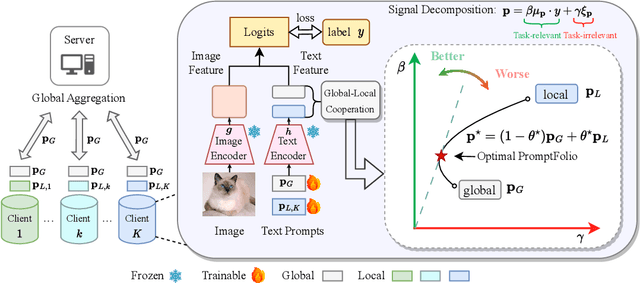

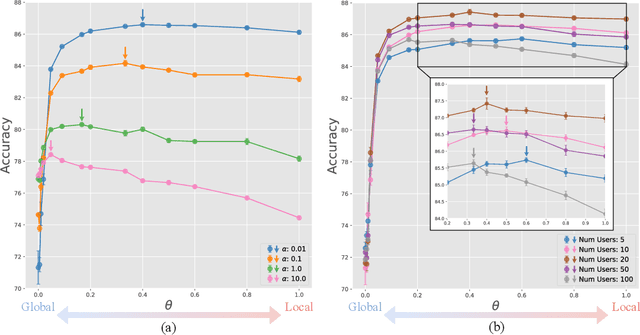

Abstract:Integrating pretrained vision-language foundation models like CLIP into federated learning has attracted significant attention for enhancing generalization across diverse tasks. Typically, federated learning of vision-language models employs prompt learning to reduce communication and computational costs, i.e., prompt-based federated learning. However, there is limited theoretical analysis to understand the performance of prompt-based federated learning. In this work, we construct a theoretical analysis framework for prompt-based federated learning via feature learning theory. Specifically, we monitor the evolution of signal learning and noise memorization in prompt-based federated learning, demonstrating that performance can be assessed by the ratio of task-relevant to task-irrelevant coefficients. Furthermore, we draw an analogy between income and risk in portfolio optimization and the task-relevant and task-irrelevant terms in feature learning. Leveraging inspiration from portfolio optimization that combining two independent assets will maintain the income while reducing the risk, we introduce two prompts: global prompt and local prompt to construct a prompt portfolio to balance the generalization and personalization. Consequently, we showed the performance advantage of the prompt portfolio and derived the optimal mixing coefficient. These theoretical claims have been further supported by empirical experiments.
Monocular Human-Object Reconstruction in the Wild
Jul 31, 2024Abstract:Learning the prior knowledge of the 3D human-object spatial relation is crucial for reconstructing human-object interaction from images and understanding how humans interact with objects in 3D space. Previous works learn this prior from datasets collected in controlled environments, but due to the diversity of domains, they struggle to generalize to real-world scenarios. To overcome this limitation, we present a 2D-supervised method that learns the 3D human-object spatial relation prior purely from 2D images in the wild. Our method utilizes a flow-based neural network to learn the prior distribution of the 2D human-object keypoint layout and viewports for each image in the dataset. The effectiveness of the prior learned from 2D images is demonstrated on the human-object reconstruction task by applying the prior to tune the relative pose between the human and the object during the post-optimization stage. To validate and benchmark our method on in-the-wild images, we collect the WildHOI dataset from the YouTube website, which consists of various interactions with 8 objects in real-world scenarios. We conduct the experiments on the indoor BEHAVE dataset and the outdoor WildHOI dataset. The results show that our method achieves almost comparable performance with fully 3D supervised methods on the BEHAVE dataset, even if we have only utilized the 2D layout information, and outperforms previous methods in terms of generality and interaction diversity on in-the-wild images.
StackFLOW: Monocular Human-Object Reconstruction by Stacked Normalizing Flow with Offset
Jul 30, 2024



Abstract:Modeling and capturing the 3D spatial arrangement of the human and the object is the key to perceiving 3D human-object interaction from monocular images. In this work, we propose to use the Human-Object Offset between anchors which are densely sampled from the surface of human mesh and object mesh to represent human-object spatial relation. Compared with previous works which use contact map or implicit distance filed to encode 3D human-object spatial relations, our method is a simple and efficient way to encode the highly detailed spatial correlation between the human and object. Based on this representation, we propose Stacked Normalizing Flow (StackFLOW) to infer the posterior distribution of human-object spatial relations from the image. During the optimization stage, we finetune the human body pose and object 6D pose by maximizing the likelihood of samples based on this posterior distribution and minimizing the 2D-3D corresponding reprojection loss. Extensive experimental results show that our method achieves impressive results on two challenging benchmarks, BEHAVE and InterCap datasets.
Uniform Transformation: Refining Latent Representation in Variational Autoencoders
Jul 02, 2024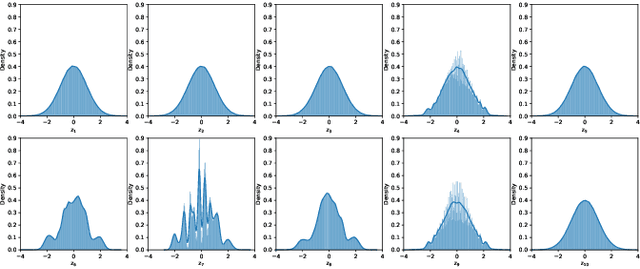
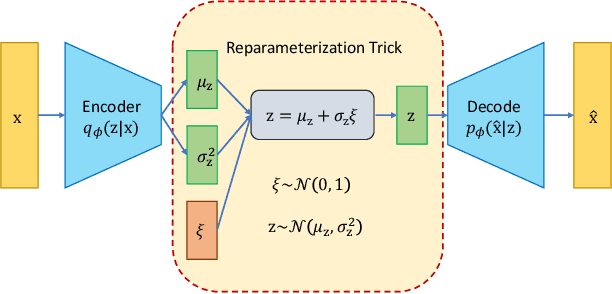
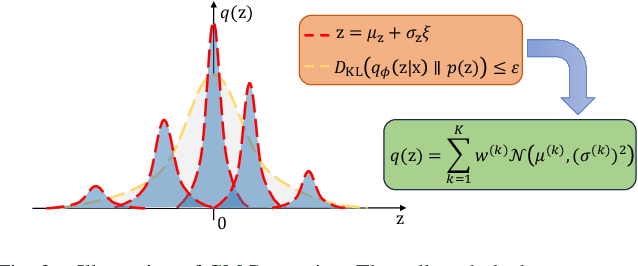
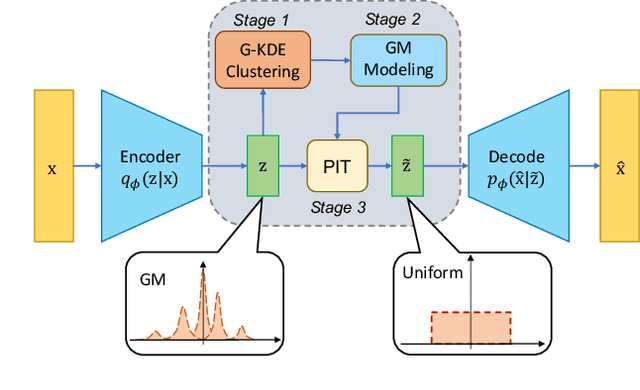
Abstract:Irregular distribution in latent space causes posterior collapse, misalignment between posterior and prior, and ill-sampling problem in Variational Autoencoders (VAEs). In this paper, we introduce a novel adaptable three-stage Uniform Transformation (UT) module -- Gaussian Kernel Density Estimation (G-KDE) clustering, non-parametric Gaussian Mixture (GM) Modeling, and Probability Integral Transform (PIT) -- to address irregular latent distributions. By reconfiguring irregular distributions into a uniform distribution in the latent space, our approach significantly enhances the disentanglement and interpretability of latent representations, overcoming the limitation of traditional VAE models in capturing complex data structures. Empirical evaluations demonstrated the efficacy of our proposed UT module in improving disentanglement metrics across benchmark datasets -- dSprites and MNIST. Our findings suggest a promising direction for advancing representation learning techniques, with implication for future research in extending this framework to more sophisticated datasets and downstream tasks.
 Add to Chrome
Add to Chrome Add to Firefox
Add to Firefox Add to Edge
Add to Edge